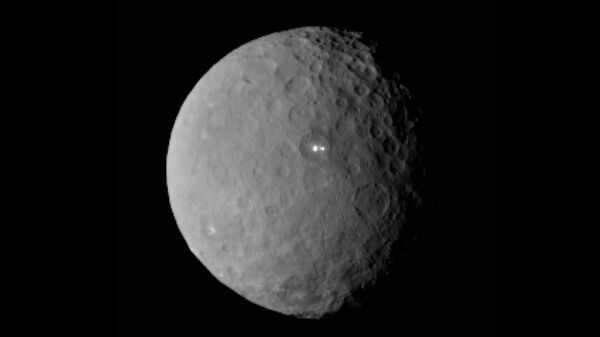https://sputnikglobe.com/20200811/dwarf-planet-ceres-turns-out-to-be-ocean-world-new-study-says-as-scientists-hunt-for-signs-of-life-1080137288.html
Dwarf Planet Ceres Turns Out to Be Ocean World, New Study Says as Scientists Hunt For Signs of Life
Dwarf Planet Ceres Turns Out to Be Ocean World, New Study Says as Scientists Hunt For Signs of Life
Sputnik International
Named after the Roman goddess of agriculture and fertility, Ceres is part of an asteroid belt that lies between the orbits of Mars and Jupiter. For a long... 11.08.2020, Sputnik International
2020-08-11T18:21+0000
2020-08-11T18:21+0000
2023-06-20T17:12+0000
newsfeed
science & tech
society
ceres
astronomy
space exploration
https://cdn1.img.sputnikglobe.com/img/102085/35/1020853581_0:0:1080:608_1920x0_80_0_0_fddb83fd71d4d17b4095445470706bf3.jpg
The dwarf planet Ceres is actually an ocean world, claims new study conducted by an international team of scientists from Europe and the United States. According to several studies, published on 10 August in the journals Nature Astronomy, Nature Geoscience, and Nature Communications, Ceres is home to large reservoirs of brine (salt-enriched water) that flows beneath its freezing surface.According to one of the studies, the scientists came to this conclusion after analysing data received from NASA’s Dawn space probe that examined Ceres for three years. Using infrared imaging, the researchers discovered a mineral called hydrohalite, which forms in brines at cold temperatures.The researchers say the presence of hydrohalite is a sign that the dwarf planet, discovered in 1801 by Italian astronomer Giuseppe Piazzi, used to have water and could have hosted life. "The material found on Ceres is extremely important in terms of astrobiology. We know that these minerals are all essential for the emergence of life", said Maria Cristina De Sanctis, from Rome’s National Institute of Astrophysics.The scientists note that hydrohalite is unstable on Ceres’ surface, which means that it formed on the dwarf planet very recently.
Sputnik International
feedback@sputniknews.com
+74956456601
MIA „Rossiya Segodnya“
2020
News
en_EN
Sputnik International
feedback@sputniknews.com
+74956456601
MIA „Rossiya Segodnya“
Sputnik International
feedback@sputniknews.com
+74956456601
MIA „Rossiya Segodnya“
newsfeed, science & tech, society, ceres, astronomy, space exploration
newsfeed, science & tech, society, ceres, astronomy, space exploration
Dwarf Planet Ceres Turns Out to Be Ocean World, New Study Says as Scientists Hunt For Signs of Life
18:21 GMT 11.08.2020 (Updated: 17:12 GMT 20.06.2023) Named after the Roman goddess of agriculture and fertility, Ceres is part of an asteroid belt that lies between the orbits of Mars and Jupiter. For a long time, scientists believed that Ceres was a desolate space rock.
The dwarf planet Ceres is actually an ocean world, claims new study conducted by an international team of scientists from Europe and the United States. According to several studies, published on 10 August in the journals
Nature Astronomy, Nature Geoscience, and
Nature Communications, Ceres is home to large reservoirs of brine (salt-enriched water) that flows beneath its freezing surface.
According to one of the studies, the scientists came to this conclusion after analysing data received from
NASA’s Dawn space probe that examined Ceres for three years. Using infrared imaging, the researchers discovered a mineral called hydrohalite, which forms in brines at cold temperatures.
"This elevates Ceres to 'ocean world' status, noting that this category does not require the ocean to be global. In the case of Ceres, we know the liquid reservoir is regional scale but we cannot tell for sure that it is global. However, what matters most is that there is liquid on a large scale”, said Carol Raymond, a planetary scientist and Dawn's principal investigator.
The researchers say the presence of hydrohalite is a sign that the dwarf planet, discovered in 1801 by Italian astronomer Giuseppe Piazzi, used to have water and could have hosted life. "The material found on Ceres is extremely important in terms of astrobiology. We know that these minerals are all essential for the emergence of life", said Maria Cristina De Sanctis, from Rome’s National Institute of Astrophysics.
The scientists note that hydrohalite is unstable on Ceres’ surface, which means that it formed on the dwarf planet very recently.

